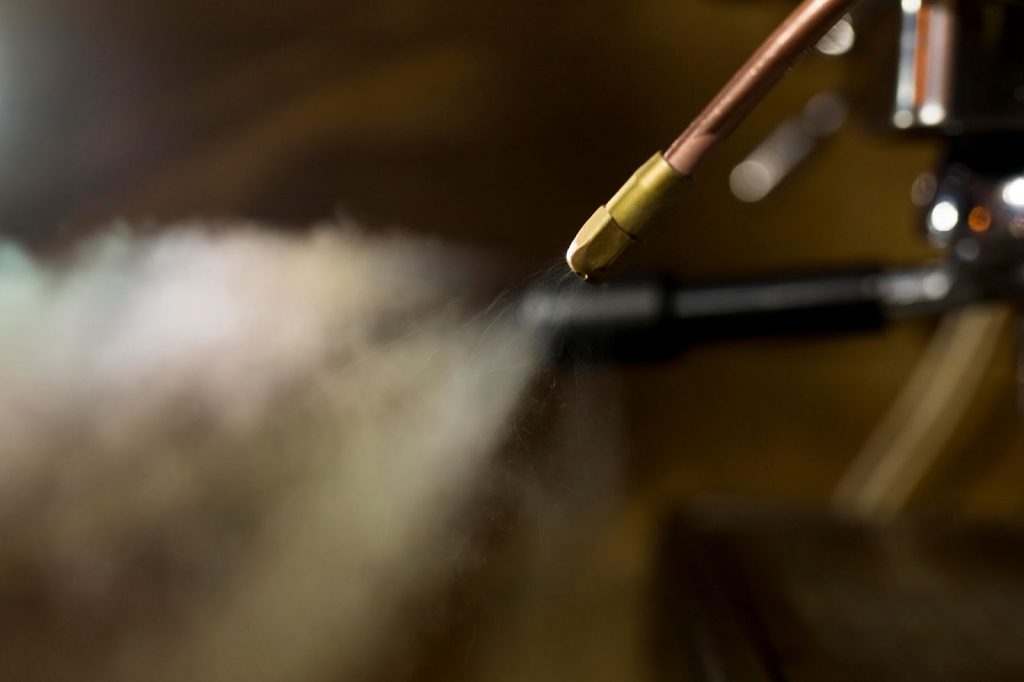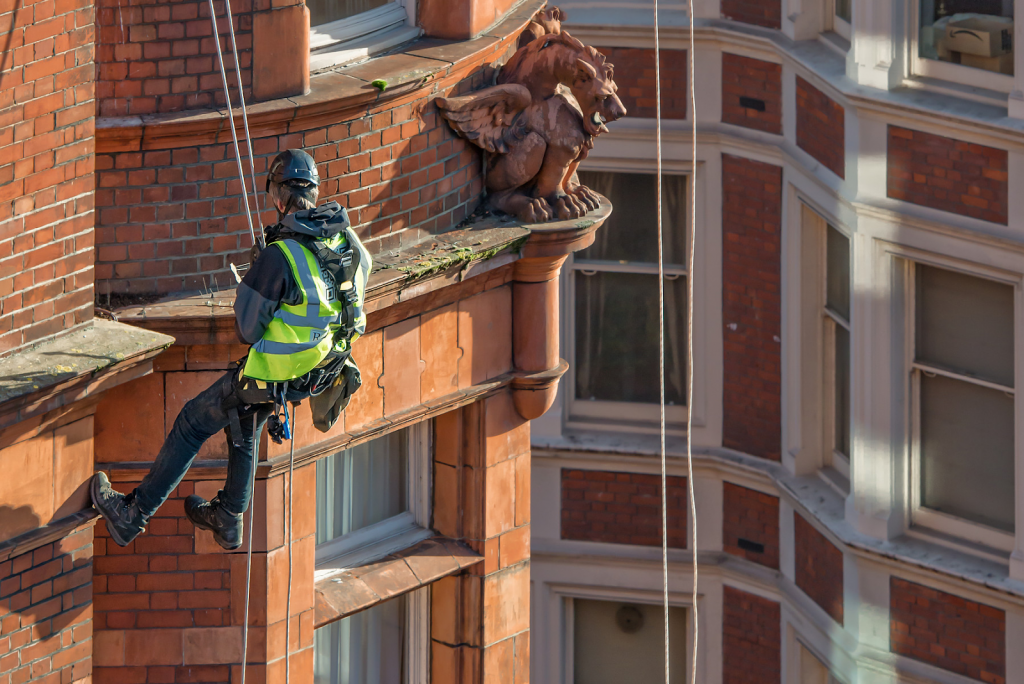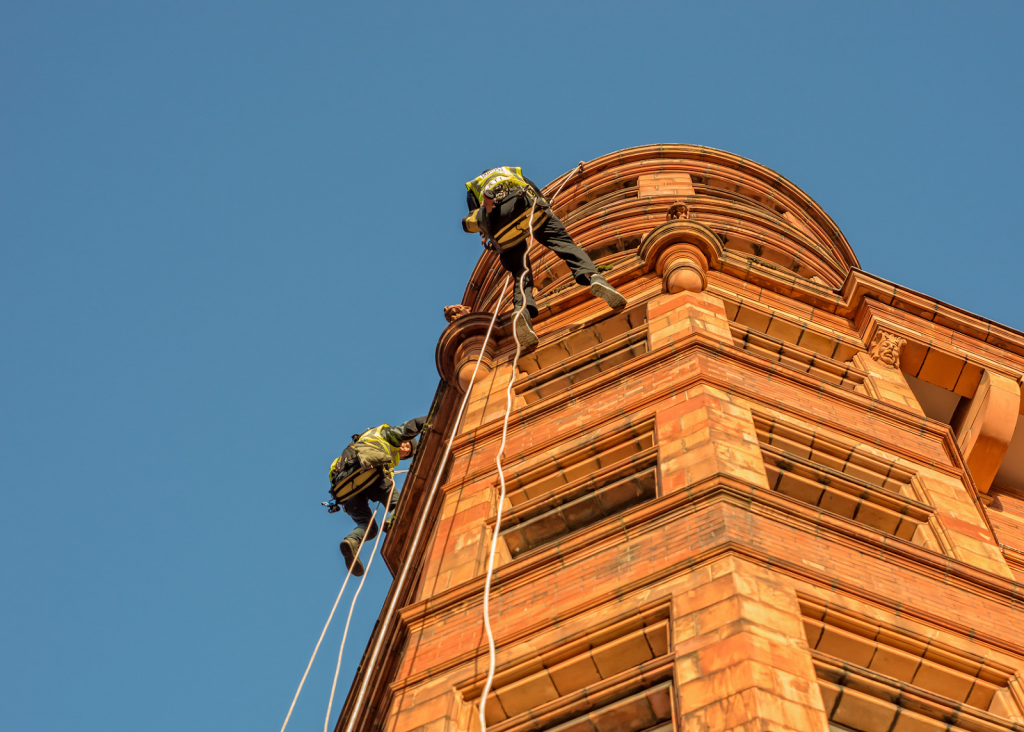
There’s something undeniably charming about a well-maintained brick or terracotta facade. But here’s the thing: these materials magnets for grime, pollution, biological growth, and all manner of urban nastiness.
At Rope Access in London (RAIL), we’ve spent years working on facades, and we’ve seen it all — from surfaces that just need a gentle wash to brickwork so encrusted with decades of soot that it’s barely recognisable.
Cleaning brick and terracotta isn’t just about aesthetics, though that’s certainly part of it. It’s also about preservation. Salt damage, biological growth, and pollution can all compromise the integrity of your facade over time.
In this guide, we’ll walk you through everything you need to know about cleaning brick and terracotta facades.
Why Do Brick and Terracotta Facades Turn from Beautiful to Begrimed?
Let’s start with the enemy. Understanding what you’re up against is half the battle when it comes to facade cleaning.
Brick and terracotta are both fired clay products, which means they’re porous and textured — two qualities that make them prime real estate for dirt and growth.
The Urban Assault Course
If your building is in London or any other major city, it’s under constant assault from atmospheric pollution. Carbon particles from vehicle exhausts, sulphur dioxide from industrial processes, and general particulate matter all settle on facades, creating that telltale black crust we see on so many historic buildings.
We see this constantly in our commercial building maintenance work across London. A building might have looked pristine twenty years ago, but decades of traffic pollution can transform it into something barely recognisable.
The good news? Most of this can be reversed with the right cleaning approach.
The Green Menace
Then there’s biological growth. Algae, moss, lichen, and even higher plants love to make their home on brick and terracotta, especially on north-facing elevations or areas with poor drainage.
These organisms hold moisture against the surface, accelerating deterioration. Their root systems (even tiny ones) can work their way into joints and pores, causing mechanical damage as they grow.
When we’re called in for cleaning projects on residential properties, biological growth is often the primary concern. It’s particularly problematic on terracotta, which tends to be even more porous than brick and can harbour quite substantial colonies of plant life if left unchecked.
Salt of the Earth (and the Problem)
Efflorescence — those white, powdery deposits that appear on brickwork — is actually salt that’s been drawn out of the brick or mortar by moisture movement. While it looks alarming, it’s usually just a cosmetic issue.
However, if salts are crystallising within the brick rather than on the surface (a condition called subflorescence), they can cause serious spalling and deterioration.

What’s the Best Way to Clean Different Types of Facade Grime?
Now that we know what we’re dealing with, let’s talk about the solutions. The wrong cleaning method can do more harm than good, which is why we always conduct a thorough assessment before starting any work.
Low-Pressure Water Cleaning
For many situations, good old water is your best friend. Low-pressure steam cleaning or nebulous spray systems can remove a surprising amount of dirt without damaging the substrate. This method is frequently used in cleaning services because it’s non-abrasive and doesn’t introduce chemicals into the equation.
The key word here is “low-pressure.” High-pressure jet washing might seem like a quick fix, but it can erode soft bricks, blast away pointing, and drive water deep into the structure where it can cause damp problems.
Steam cleaning is particularly effective because the heat helps to break down organic matter and grease. It’s also excellent for biological growth — a good steam clean can kill algae and moss spores, reducing the likelihood of regrowth.
Chemical Warfare
Sometimes water alone won’t cut it. For heavy soiling, biological growth, or paint removal, chemical cleaning might be necessary. This is where things get technical, and honestly, where DIY attempts often go wrong.
Different chemicals are suited to different problems and different substrates, and using the wrong one can cause permanent staining or damage.
Abrasive Cleaning
Abrasive methods — using materials like crushed glass, plastic beads, or even wheat starch propelled at the surface — can remove stubborn deposits that resist other methods. However, this is serious business and absolutely not a DIY job.
Get it wrong, and you can remove the fire skin from bricks, exposing the softer interior to weathering and accelerating deterioration.
Abrasive cleaning is often the method of choice for removing old paint or coatings that are themselves causing damage. The technique requires specialist equipment and a very steady hand.
Why Our Approach Works
When we founded Rope Access in London, we did so with a simple philosophy: buildings deserve care from people who genuinely understand them.
Whether we’re cleaning a brick facade, installing cladding, carrying out glazing work, or installing large format banners on commercial buildings, we approach each project with the same commitment to quality and safety.
Our team includes not just cleaners but also qualified welders, electricians, painters, and plumbers — specialists who understand buildings from the inside out. This comprehensive skill set means we can address issues as we find them.
Maintaining Your Facade After Cleaning
Facade cleaning isn’t a once-and-done deal. Maintenance is key to preserving your investment and keeping your building looking its best.
In central London, buildings might need cleaning every three to five years to prevent heavy soiling buildup. In less polluted areas, you might stretch that to seven or ten years. Still, regular inspection is crucial — catching problems early means simpler, cheaper interventions.
Conclusion: Your Facade Deserves Expert Care
Brick and terracotta facades are among the most beautiful and enduring building materials, but they need proper care to remain that way. Cleaning these surfaces is part science, part art, and entirely dependent on using the right methods for the specific situation at hand.
At Rope Access in London, we bring together the skills, equipment, and experience needed to clean brick and terracotta facades safely and effectively. From our rope access capabilities to our team of multi-disciplined specialists, we’re equipped to handle projects of any scale or complexity.


















